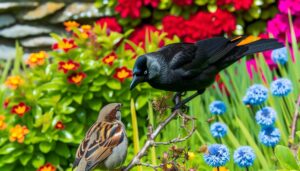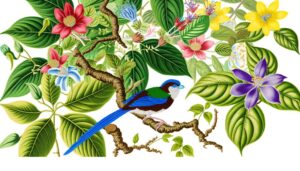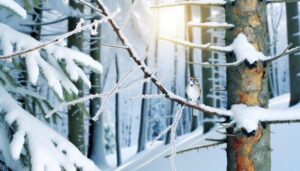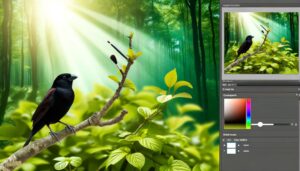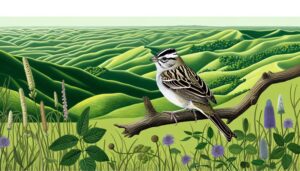7 Effective Tips to Keep Sparrows Out of Blue Bird Boxes
To keep sparrows out of bluebird boxes, one should prioritize specific strategies. To start with, place bluebird boxes in open areas, away from buildings, which sparrows favor.
Use boxes with hole diameters of 1.5 inches to deter sparrows and install slot entrances. Regularly inspect and remove sparrow nests, and provide alternative nesting sites to divert them.
Employ deterrents like sparrow spookers. Cleaning and maintaining bluebird boxes weekly guarantees native birds' success.
Adopting these techniques promotes bluebird habitation while dissuading sparrows. Further insights on practical steps await keen conservationists ready to protect native bird populations.
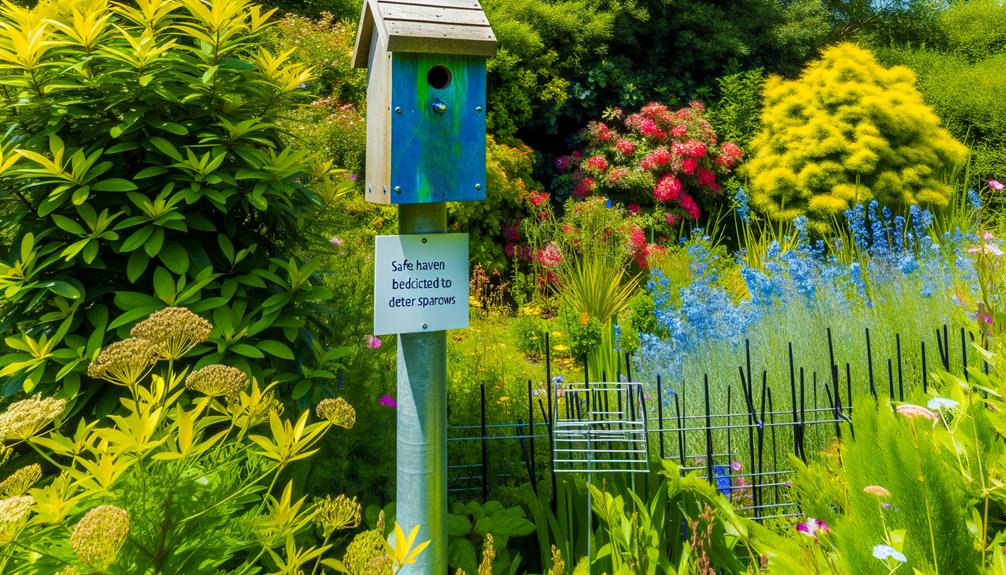
Key Takeaways
- Use entrance holes 1.5 inches in diameter to deter larger House Sparrows from entering bluebird boxes.
- Install sparrow spookers or slot entrances to discourage sparrows from nesting in bluebird boxes.
- Regularly inspect and remove any sparrow nests found in bluebird boxes to prevent them from taking over.
- Place bluebird boxes in open areas away from buildings and dense vegetation where sparrows prefer to nest.
- Clean and maintain bluebird boxes frequently to ensure they are attractive and safe for bluebirds, not sparrows.
Understand Sparrow Behavior
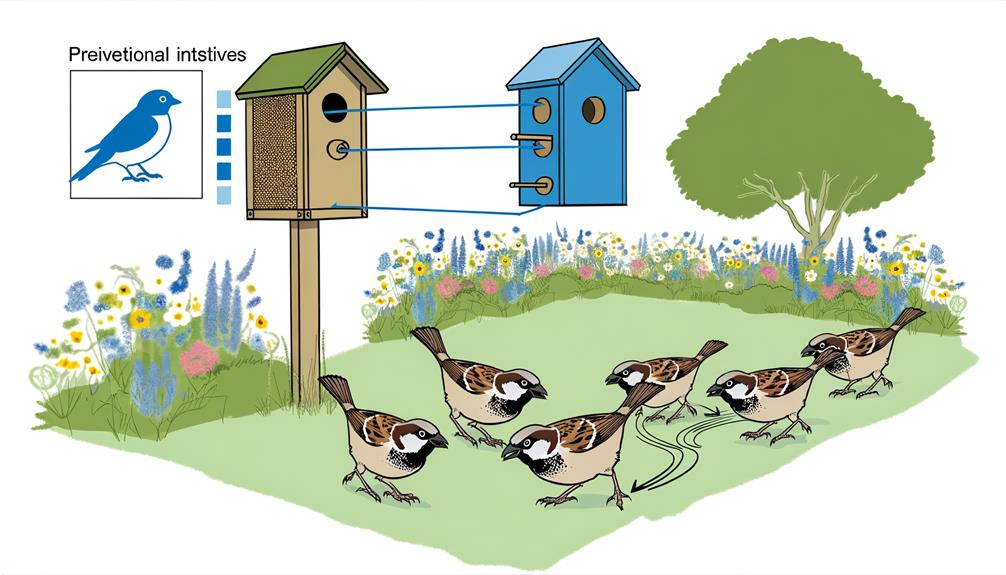
Understanding sparrow behavior is essential for implementing effective strategies to prevent them from invading bluebird boxes. House Sparrows (Passer domesticus), an invasive species, are aggressive and territorial, often displacing native bluebirds. They exhibit a high degree of site fidelity, returning to previously occupied nesting sites.
Sparrows prefer nesting in cavities and show a proclivity for urban and suburban environments. Their nesting material generally consists of coarse grasses, feathers, and litter, which can be a telltale sign of their presence. Observations reveal that sparrows are most active during early morning and late afternoon, making these times critical for monitoring and intervention.
Choose the Right Location
Selecting the best location for bluebird boxes involves considering factors such as habitat type, distance from human activity, and proximity to food sources to minimize the likelihood of sparrow intrusion.
Ideally, bluebird boxes should be placed in open, grassy areas with scattered trees and shrubs, which are less appealing to house sparrows.
Ensuring a minimum distance of 50 to 100 yards from buildings and other human activities can further reduce sparrow competition.
Proximity to natural food sources like insects and berries should also be prioritized, as it supports bluebird sustenance while deterring sparrows, who prefer grain and seed-rich environments.
This strategic placement leverages ecological preferences, promoting bluebird habitation over invasive sparrow occupation.
Use Proper Box Dimensions
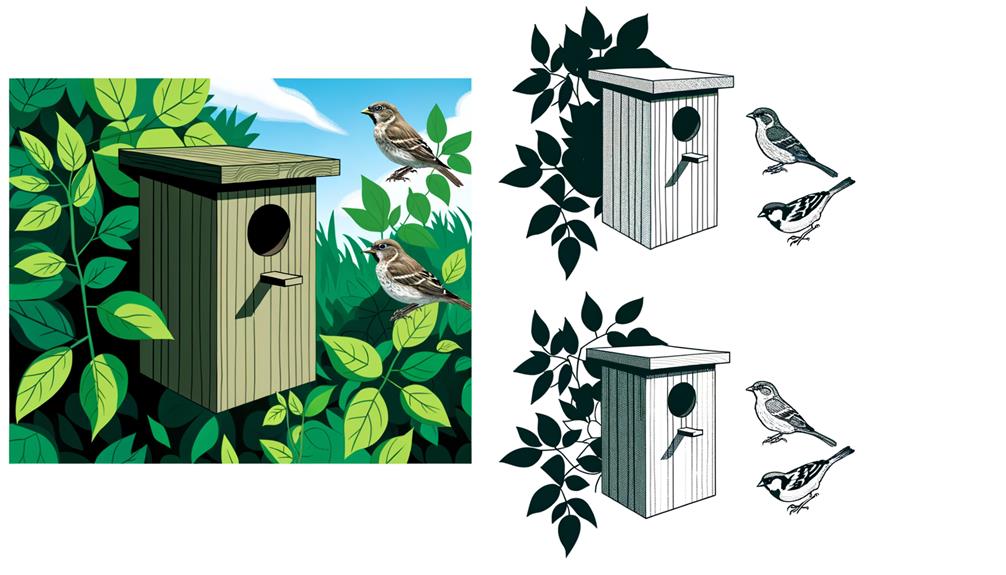
Ensuring proper box dimensions is critical for deterring sparrows and attracting bluebirds. Specific measurements for the entrance hole, such as a diameter of 1.5 inches, limit access to larger, unwanted species.
Additionally, maintaining recommended interior space and proper box height placement are essential for creating a suitable habitat for bluebirds.
Entrance Hole Size
By carefully selecting the entrance hole size to be precisely 1.5 inches in diameter, one can effectively deter sparrows from entering bluebird boxes while still accommodating the intended avian inhabitants.
Scientific observations indicate that sparrows, particularly the invasive House Sparrow (Passer domesticus), struggle to fit through openings smaller than 1.5 inches. This specific diameter is, however, ideal for Eastern Bluebirds (Sialia sialis), granting them exclusive access to the nesting box.
The precision in hole sizing is crucial; even slight deviations can lead to unwanted intrusions. Implementing this technical specification not only protects bluebird populations but also ensures that native species thrive without interference, preserving the natural ecosystem.
Hence, meticulous adherence to entrance hole dimensions fosters a balanced avian habitat.
Interior Space Measurements
Accurate interior space measurements, including a floor area of at least 5×5 inches and a height of 8-12 inches, play a crucial role in creating an ideal nesting environment for bluebirds while deterring sparrows.
Bluebirds prefer larger nesting boxes, which provide sufficient space for their broods and comfort. Conversely, sparrows, which are more adaptable to smaller confines, find these dimensions less attractive.
Precision in these measurements ensures ideal ventilation, reducing humidity levels that could harm bluebird eggs. The floor area must be spacious enough to allow bluebird fledglings to move freely yet restrictive enough to discourage sparrow occupation.
Proper interior dimensions are essential to meet the specific nesting habits of bluebirds, effectively minimizing competition from sparrows.
Box Height Placement
Proper box height placement is another critical factor in keeping sparrows out of bluebird boxes, directly influencing bluebird occupancy rates and sparrow deterrence.
Bluebirds prefer nest boxes placed at specific heights, making them less accessible to sparrows. Recommended heights for best results are:
- 4 to 6 feet: This height range is ideal for Eastern Bluebirds, providing a balance between accessibility and safety.
- Eye-level monitoring: Positioning boxes at eye level allows for easy monitoring and maintenance without disturbing the birds.
- Avoiding predator zones: Placing boxes away from dense shrubbery and low branches reduces the risk of predators.
- Proper post installation: Secure posts with predator baffles to prevent climbing intruders, ensuring bluebird safety.
Install Sparrow Spookers
To effectively deter sparrows, one can install sparrow spookers—devices specifically designed to create visual disturbances that discourage sparrows from approaching bluebird nesting boxes.
Sparrow spookers typically consist of reflective materials such as Mylar strips or shiny ribbons. These materials flutter in the wind, generating motion and light reflections that sparrows find unsettling.
Installation should occur immediately after bluebirds begin nesting, as early application guarantees minimal sparrow interference. The spooker should be securely attached to the top of the bluebird box, with the reflective streamers hanging freely.
While sparrow spookers are effective, they must be monitored regularly to ensure they remain operational and don't inadvertently disturb the bluebirds. This method offers a non-invasive, freedom-supporting solution to manage nesting environments.
Opt for Slot Entrances
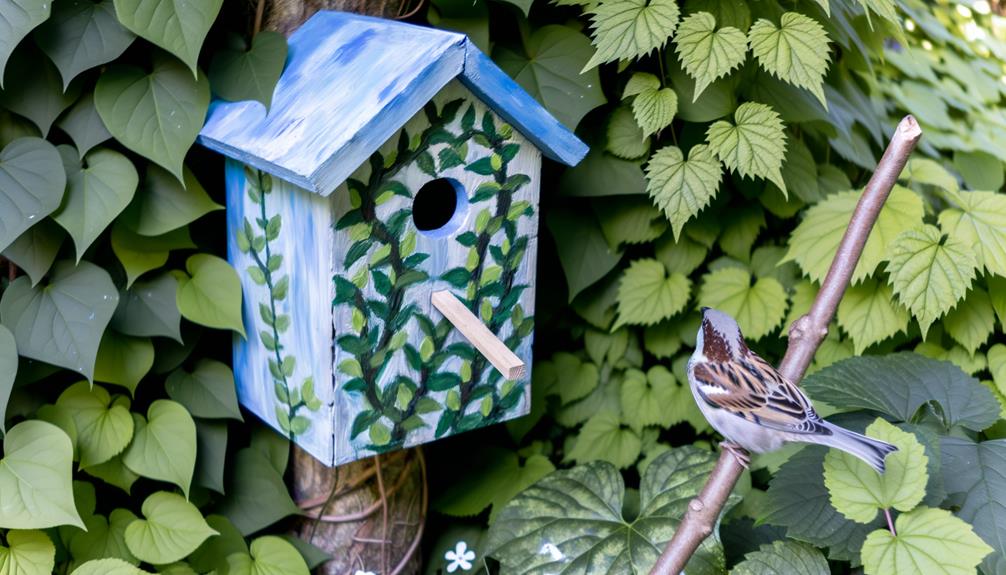
By incorporating slot entrances into bluebird nesting boxes, individuals can reduce the likelihood of sparrow intrusion due to the latter's preference for traditional round openings. This modification leverages the size and shape preferences of different bird species, creating a more selective environment.
Slot entrances, typically measuring 1.125 inches in height and 2.25 inches in width, allow bluebirds but deter sparrows.
Studies have demonstrated that slot entrances enhance nest box efficacy by:
- Restricting Access: The dimensional constraints prevent larger sparrows from entering.
- Reducing Competition: Bluebirds face less nest site competition.
- Enhancing Occupancy: Bluebirds are more likely to use boxes with slot entrances.
- Decreasing Aggression: Sparrows are less likely to engage in territorial disputes over these boxes.
This method aligns with the objective of ensuring bluebird nesting success.
Remove Sparrow Nests
Regular removal of sparrow nests significantly reduces their occupancy and enhances bluebird nesting success. When sparrows establish nests in bluebird boxes, prompt removal is necessary. Observers should identify sparrow nests by their loosely assembled materials, including rough grasses, feathers, and debris.
Using gloves, one should remove the entire nest, ensuring no eggs or young sparrows are left behind. This task must be carried out diligently, as sparrows are persistent nesters. Employing a structured approach to nest removal interrupts their breeding cycle, deterring re-nesting.
Performing removals during the early breeding season is vital to maximize bluebird habitation. Consistent inspections and nest removal practices establish a favorable environment for bluebirds, supporting their reproductive success and contributing to their population stability.
Monitor Bluebird Boxes
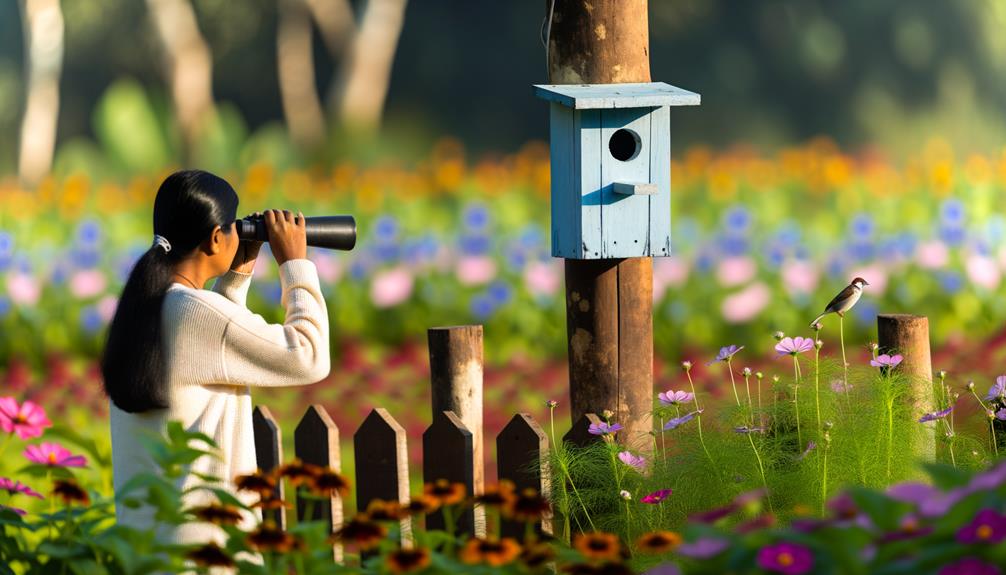
Consistently monitoring bluebird boxes is necessary for ensuring the health and safety of bluebird nests, as well as for early detection of potential threats. Regular inspections allow for the identification and mitigation of issues like sparrow encroachment.
Observers should:
- Check nest status: Verify if the nest is occupied by bluebirds or sparrows.
- Assess egg count: Count and record the number of eggs, noting any anomalies.
- Inspect for damage: Look for signs of structural damage or predator intrusion.
- Document activity: Maintain a log of observations, including dates and specific findings.
These actions help maintain an ideal environment for bluebird nesting success, ensuring that any intrusions or issues are swiftly addressed. Regular monitoring supports both the conservation of bluebirds and the freedom to enjoy a thriving backyard ecosystem.
Implement Sparrow Traps
Implementing sparrow traps effectively requires understanding the various types available, such as funnel traps and repeating traps.
Correct placement near bluebird boxes and precise timing during peak sparrow activity are essential for best results.
This approach minimizes sparrow interference while ensuring bluebird populations thrive.
Types of Sparrow Traps
Among the various methods to manage sparrow populations in bluebird boxes, sparrow traps stand out as an effective and humane solution. These traps can reduce the invasive sparrow population without harming other bird species.
Here are four types of sparrow traps:
- Van Ert Universal Sparrow Trap: This trap is designed to fit inside standard bluebird boxes, preserving minimal disruption to the existing bird habitat.
- Repeating Sparrow Trap: This type captures multiple birds without requiring frequent resetting, making it efficient for managing larger populations.
- Mousetrap-Style Sparrow Trap: Utilizes a spring mechanism to swiftly enclose the sparrow upon entry.
- Havahart Live Catch Trap: A ground-based trap that captures sparrows alive, allowing for safe relocation.
These traps, when used correctly, secure effective sparrow management.
Placement and Timing
To maximize the effectiveness of sparrow traps, one must carefully consider both the placement and timing of their deployment.
Strategically positioning traps near bluebird boxes guarantees higher capture rates, as sparrows often invade these specific locations. Place traps at least five feet above the ground to prevent interference from ground predators.
Deploy traps in early spring when sparrows begin establishing territories, optimizing capture before they can breed. Regular monitoring and timely removal of captured sparrows are essential to maintaining bluebird box sanctity.
Additionally, altering trap locations periodically prevents sparrows from learning to avoid them. By integrating these specific strategies, one can effectively reduce sparrow intrusion, granting bluebirds the freedom to thrive in their designated habitats.
Provide Alternative Nesting Sites
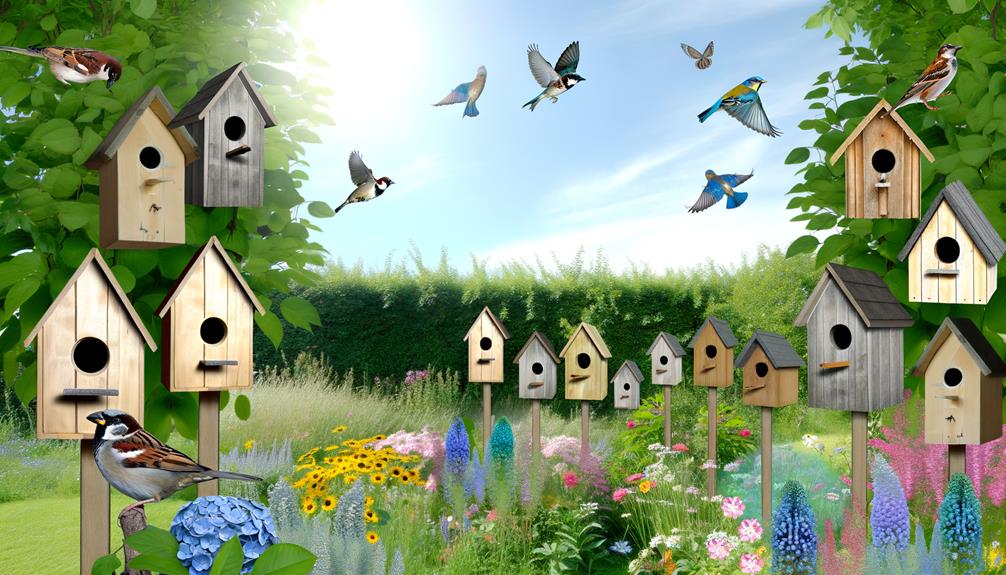
Creating alternative nesting sites can divert house sparrows away from bluebird boxes, guaranteeing that bluebirds have a secure habitat. By strategically situating these additional sites, one can effectively reduce competition and territorial disputes.
Consider the following recommendations:
- Install Sparrow-Specific Nest Boxes: These boxes should be positioned at least 50 feet away from bluebird boxes and designed with dimensions preferred by house sparrows.
- Use Decoy Sites: Set up dummy nests that replicate real ones, attracting sparrows to uninhabited areas.
- Vary Elevation: Place alternative nest boxes at different heights, as house sparrows prefer lower sites compared to bluebirds.
- Maintain Distance: Guarantee a minimum distance of 100 yards between bluebird and sparrow nesting sites to minimize interaction.
These methods guarantee bluebirds retain their nesting sites unimpeded.
Maintain Clean Boxes
Ensuring that bluebird boxes remain clean is crucial in preventing house sparrows from taking over and reducing the risk of disease. Regular cleaning deters sparrows, which are less likely to invade a well-maintained, hygienic environment.
By removing old nesting materials, parasites, and waste, one can maintain ideal conditions for bluebirds. It's advisable to clean the boxes at least twice a year, preferably in early spring and late summer. A 10% bleach solution can effectively sanitize the interior.
Additionally, inspecting the boxes for damage and ensuring proper ventilation will enhance their appeal to bluebirds. Cleanliness not only prevents sparrow infestations but also fosters a healthier habitat, providing bluebirds the freedom to thrive without competition.
Use Sparrow Repellents
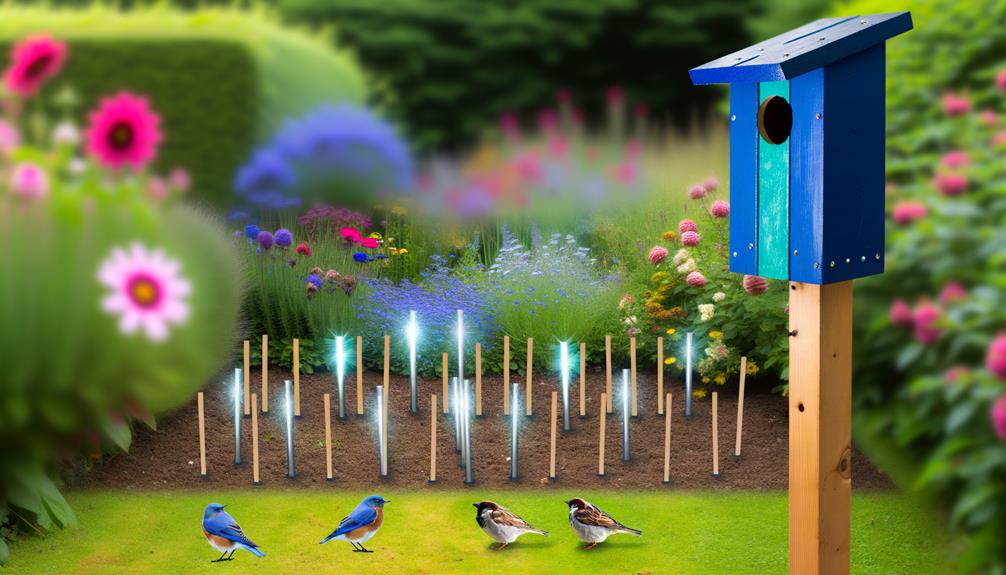
Implementing sparrow deterrents can reduce the likelihood of house sparrows occupying bluebird boxes, thereby ensuring a more appropriate environment for bluebirds. By employing specific deterrents, one can maintain an ideal nesting habitat for native avian species. Here are four effective sparrow repellent methods:
- Sparrow Spookers: These devices use reflective materials to scare sparrows away without disturbing bluebirds.
- Monofilament Lines: Strategically placing fishing line around the box entrance creates a barrier that sparrows avoid.
- Decoys: Installing fake predator models, like owls or snakes, can deter sparrows from approaching.
- Noise Emitters: Ultrasonic devices emit frequencies that are uncomfortable for sparrows but inaudible to bluebirds.
These methods, when applied correctly, can notably reduce sparrow interference.
Educate Your Neighbors
Educating neighbors is essential for effective sparrow management in bluebird conservation efforts.
Sharing accurate identification tips can help distinguish invasive sparrows from native species, while promoting support for native birds encourages community participation.
Advocating for regular box checks guarantees proactive monitoring and timely intervention.
Share Identification Tips
Accurately distinguishing between sparrows and bluebirds involves key identification markers such as plumage color, beak shape, and behavioral patterns. These distinctions are essential for anyone aiming to protect bluebird habitats.
Here are four critical identification tips:
- Plumage Color: Bluebirds exhibit vibrant blue and rust-colored feathers, while sparrows typically display brown and gray tones.
- Beak Shape: Bluebirds possess slender, pointed beaks designed for catching insects, whereas sparrows have short, conical beaks suited for seed consumption.
- Size and Shape: Bluebirds are generally larger and have more streamlined bodies compared to the compact, stout build of sparrows.
- Behavioral Patterns: Bluebirds are often seen perched in open fields, while sparrows prefer hopping on the ground or dense shrubs.
Educating neighbors helps preserve the delicate balance of local ecosystems.
Promote Native Bird Support
Understanding these identification tips empowers individuals to take proactive steps in promoting native bird support by educating their neighbors about the importance of preserving bluebird habitats. Encouraging community awareness involves sharing the ecological benefits of bluebirds, such as pest control and pollination.
Neighbors can be informed about the detrimental impact of invasive species like house sparrows, which compete for nesting sites and resources. Distributing educational materials, organizing workshops, and using social media platforms can amplify messages emphasizing native species conservation.
Providing technical advice on installing bluebird boxes correctly, including proper placement and sparrow deterrents, guarantees a united effort. By fostering neighborhood collaboration, individuals can create a supportive environment that promotes the thriving of native bluebird populations.
Advocate Regular Box Checks
By conducting regular box checks, individuals can swiftly identify and mitigate the presence of invasive house sparrows, thereby safeguarding bluebird populations. Regular monitoring ensures timely removal of sparrow nests and eggs, maintaining ideal conditions for bluebirds.
Encouraging neighbors to adopt similar practices enhances these efforts. Here's a concise strategy:
- Weekly Inspections: Check boxes at least once a week during nesting season to detect and remove house sparrow nests early.
- Identify Nests: Learn to distinguish between bluebird and house sparrow nests; sparrow nests are messy and cluttered with various materials.
- Use Sparrow Traps: Employ humane traps to capture and release sparrows away from bluebird habitats.
- Community Workshops: Organize educational sessions to inform neighbors about the importance of protecting native bluebirds.
This collaborative approach nurtures a supportive environment for bluebird conservation.
Conclusion
Coincidentally, by understanding sparrow behavior and strategically choosing bluebird box locations, enthusiasts can successfully deter sparrows. Utilizing proper box dimensions, sparrow spookers, and slot entrances further guarantees bluebirds thrive. Providing alternative nesting sites and maintaining clean boxes are vital steps. Implementing sparrow repellents and educating neighbors completes the strategy.
Through these combined efforts, it's not just about protecting bluebirds but fostering a harmonious environment where both species can coexist without conflict.

